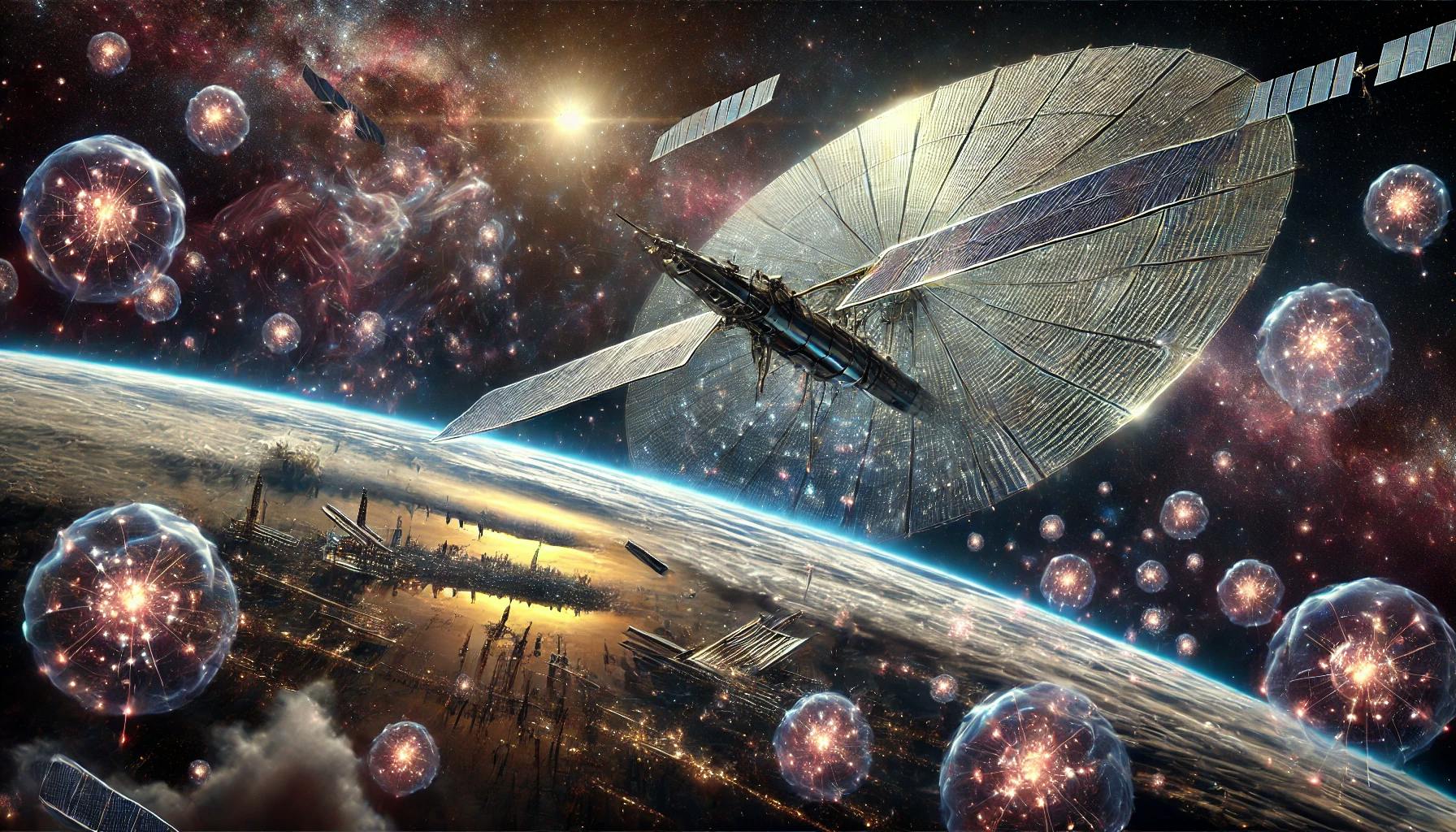When people hear the word intergalactic, they often imagine the crew of a Star Trek starship or perhaps UFOs piloted by small, gray, big-eyed aliens. But what would an alien species truly capable of interstellar travel look like in reality? In this article, I will explore what I believe to be the most plausible scenario, based on what we currently understand about the universe.
Since Einstein, we have known that the speed of light is an absolute limit. No known physical process allows us to surpass it. Unfortunately, this presents a significant challenge for any potential encounter with extraterrestrial civilizations. The vast distances between stars could serve as an insurmountable barrier.
If we assume that life emerged randomly through evolutionary processes, then, given the sheer scale of the universe, intelligent life has likely developed in many places. However, the probability of such a civilization arising nearby (in interstellar terms) is extremely low. Here, nearby means within a few hundred light-years. Even at the fastest possible speed (light speed) such a journey would still take thousands of years.
For us to meet an alien species in the present day, they would have needed to achieve interstellar travel thousands of years ago and, crucially, set course in precisely the right direction. Our solar system is just a speck on a vast spherical shell spanning thousands of light-years, and the odds of an alien civilization randomly choosing this specific point as its destination are astronomically small.
Moreover, embarking on such a journey requires an immense commitment. Even if an advanced species managed to pinpoint our location in space, there’s still the issue of timing. If they developed interstellar travel far earlier than us, they might have arrived when Earth was still devoid of intelligent life. If they emerged later, they could arrive to find humanity already extinct.
Paradoxically, the enormous size of the universe leads to two seemingly contradictory truths: intelligent life almost certainly exists beyond Earth, yet we are highly unlikely ever to encounter it.
However, it would be a mistake to conclude from this that extraterrestrial civilizations do not exist at all.
Interstellar Travel
There’s a good Wikipedia entry on interstellar travel that explores the various possibilities. At first glance, warp drives and wormholes seem like the most promising solutions, as they theoretically allow for faster-than-light travel. However, the bad news is that these concepts remain purely fictional—essentially just mathematical curiosities playing with Einstein’s equations. There is currently no scientific evidence that they exist or that they could ever be realized. If we restrict ourselves to what is feasible based on our current understanding of physics, we must rule them out as viable options.
Other propulsion methods, such as nuclear or fusion-powered spacecraft, would still be far too slow for practical interstellar travel. Additionally, they would require carrying an enormous amount of fuel, which presents another major challenge. Harvesting fuel along the journey might be an option, but it’s uncertain whether the interstellar medium contains enough resources to make this feasible.
Antimatter propulsion is another theoretical possibility, but there’s a big problem: naturally occurring antimatter is virtually nonexistent in the universe (which is fortunate for us, as its presence would be catastrophic). That means we would have to manufacture it ourselves, requiring an unfathomable amount of energy. And even if we could produce it, we’d still need to store and transport it safely.
One of the more exotic ideas involves using Hawking radiation as a power source. This would require harnessing the energy of a small black hole—a collapsed star—essentially storing it in the spacecraft’s engine. Needless to say, this is far from a simple engineering challenge.
Given our current level of scientific understanding, the most viable option for interstellar travel appears to be solar sails. These consist of enormous reflective surfaces that are propelled by intense laser beams from their point of origin. Light exerts radiation pressure, just like a stream of particles, allowing the sail to accelerate a spacecraft. The major advantage of this method is that it doesn’t require carrying any fuel, and in theory, it could approach relativistic speeds (a significant fraction of the speed of light).
However, there remains one critical issue: mass. The larger and heavier a spacecraft is, the more energy is required to accelerate it. A fully equipped starship, with a crew, life support systems, and food supplies, would have enormous mass. To sustain such a long journey, it would need to function as a self-sustaining ecosystem—a miniature, Earth-like biosphere. This, in turn, means building a massive spacecraft that would require an extraordinary amount of energy to propel.
Ultimately, the problem is that humans are not built for space travel.
Our biological needs—temperature control, food, oxygen—make interstellar voyages incredibly challenging. A far more practical solution would be to send machines instead. However, due to the vast distances involved, real-time communication would be impossible (again, because of that pesky speed of light limit). That means we would need to send an intelligent machine, capable of independent thought and decision-making.
The ideal scenario? A machine that could host human consciousness. This wouldn’t violate any known physical laws, and according to modern science, it should theoretically be achievable. If an advanced alien civilization were preparing for interstellar travel, they would likely develop computers capable of simulating their minds. If we believe futurists like Ray Kurzweil, humans ourselves might reach this capability within a few decades.
A spacecraft optimized for this kind of journey could be extremely small and lightweight—similar to the Field Circus, a concept from Charles Stross’s novel Accelerando. This fictional interstellar probe consists of a solar sail and a computer the size of a soda can, which houses both the ship’s virtual crew and their simulated environment.
The distinction between a highly advanced space probe and a miniature starship with a digital crew is largely a matter of definition. In my view, the latter is more accurate. If an alien species on the other side of the galaxy faced the same challenges as we do, they might develop a similar solution.
Thus, my vision of interstellar aliens is not Klingons or little gray men, but solar sail-propelled tin cans, carrying digital minds across the cosmos.
Colonizing New Worlds
So, we have our ideal interstellar spacecraft—but what exactly can a tin can do once it reaches its destination? Most likely, it would be programmed to conduct observations, or more ambitiously, to colonize the distant celestial body. In this case, colonization doesn’t mean settling the planet with biological life forms but rather filling it with more of these tin cans. After all, a species that exists in a purely digital form would have no reason to revert to an outdated physical body.
Given that mass is a critical constraint, carrying construction materials from the homeworld is impractical. Instead, the spacecraft must utilize the raw materials of the planet itself. A modern-day equivalent to this process might be 3D printing, but obviously, transporting a massive printer across interstellar space isn’t feasible. A more efficient approach would be to build from the ground up—starting at the smallest possible scale.
This is where nanobots come into play. The spacecraft would deploy self-replicating nanoscale machines onto the planet’s surface, which would then extract and process local materials. These nanobots would first multiply exponentially, then begin assembling additional tin can units, as well as any other necessary infrastructure.
The entire spacecraft could be designed from the start to break down into nanobots upon arrival, allowing its structure to dismantle itself and transform into the foundation of the new colony. The result would be a swarm-like intelligence—a vast, interconnected network of microscopic machines functioning as a collective mind. Each nanobot would have limited mobility and capabilities, but together, they would form a distributed superintelligence capable of adapting, expanding, and reshaping its environment.
Rather than biological beings, such an alien species would exist as a nanobot cloud—or more precisely, as a software entity running within that cloud.
The Galaxy-wide Network and Simulated Realities
An advanced interstellar civilization would expand its reach using nanorobots. It would launch solar sail-powered spacecraft into the unknown, traveling at speeds approaching the speed of light to reach new star systems. The ultimate goal? To build a vast, galaxy-wide network—an interstellar internet of sorts—a superintelligence that continuously expands, with its nodes consisting of colonized planets and floating relay stations in deep space.
Within this cosmic network, a simulated reality would exist—home to these post-biological, digital beings. No longer confined to physical bodies, they would travel as pure information, instantly moving between nodes at the speed of light. From their perspective, moving between two points in the network would feel instantaneous—like teleportation.
Of course, they wouldn’t break the speed of light. If one of these entities traveled 80 light-years, it would feel like a mere blink of an eye to them, but in the physical world, 80 years would have passed. A simple trip to the “neighboring” system might seem like nothing to them, but by the time they returned to their point of origin, 160 years would have elapsed in the outside world.
However, in a simulated existence, free from aging and the constraints of traditional physics, the concept of time might be fundamentally different. No matter how vivid our imagination is, we are incapable of truly comprehending such a reality. We cannot grasp how these beings would think or perceive existence.
This is a post-singularity form of life, something far beyond anything we can currently conceive.
Encounter with an Intergalactic Civilization
As I mentioned at the beginning of this article, I believe the chances of meeting such an interstellar alien civilization are extremely low. I think it’s far more likely that we will eventually evolve into something like them. But let’s entertain the thought for a moment.
In the best-case scenario, they deem us worthy and elevate us to their level, sparing us hundreds of years of technological development and effectively making us gods—at least, within their simulated reality.
A less dramatic but still favorable outcome (and perhaps the most realistic one)? They ignore us entirely. As a primitive, developing species, they may choose to leave us alone, steering clear of our solar system as a matter of policy—perhaps similar to how we protect untouched ecosystems on Earth.
Then there’s the worst-case scenario: they erase us. From their perspective, we might be an insignificant, wasteful use of resources—a primitive species taking up valuable matter that could be put to better use. Instead of leaving us to develop at our own pace, they might simply convert Earth into a giant supercomputer, repurposing its materials to simulate vast digital worlds and sentient beings on an unimaginable scale.
To borrow Elon Musk’s analogy, they might see us as nothing more than cosmic spam—clutter to be deleted.
And if that were the case, there would be no battle, no Hollywood-style war, no UFO invasion. No resistance. Just a few small meteors. We wouldn’t even notice them. Shortly after impact, self-replicating nanobots would silently spread across the planet, infiltrating everything—our environment, our water, our food. Even our bodies. We would breathe them in, drink them, consume them without ever realizing what had happened.
Then, when the time came, humanity would vanish. Instantly. No pain. No struggle. Just the quiet, seamless replacement of organic life with a vast, shimmering sea of self-assembling nanotech.
And we’d never even know we had been conquered.
There’s also another possibility—one that is arguably even more unsettling. Perhaps, instead of exterminating us, they would preserve us. Not out of compassion, but as a relic—an ancient curiosity to be studied. They might upload our consciousness and continue running our minds in a perfect simulation of Earth, keeping us in a digital reservation without our knowledge.
In fact, how can we be sure this hasn’t already happened? Perhaps we are already inside that simulation, living out our days in a digital replica of a world that no longer physically exists.
Perhaps we will never encounter extraterrestrial beings—which, given the scenarios I just described, might actually be the best possible outcome for us. But if we ever do, this is how I imagine they would be.
Of course, there’s another possibility: This might not describe an alien species at all, but rather a glimpse into our distant future…











